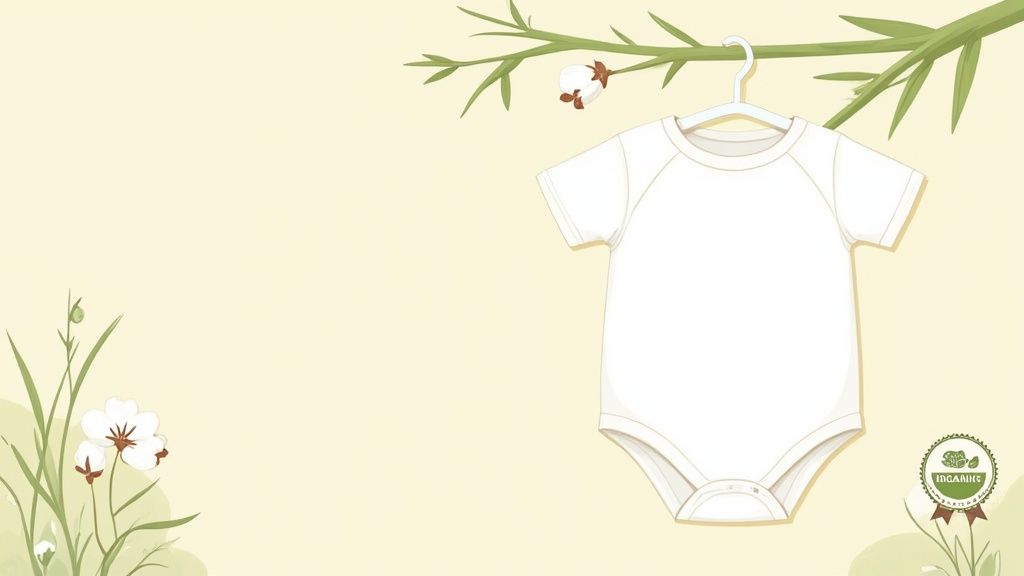
The Best Organic Baby Clothes Buyer's Guide
Share
When you're looking for the best organic baby clothes, keep an eye out for the GOTS (Global Organic Textile Standard) certification. This is your guarantee that the materials were grown without nasty chemicals and are genuinely gentle on a baby's super-sensitive skin. Brands like Burt's Bees Baby, Little Planet by Carter's, and MORI are fantastic examples of companies that nail this promise of safety and softness, giving you one less thing to worry about.
Why Organic Clothes Are a Game-Changer for Your Baby
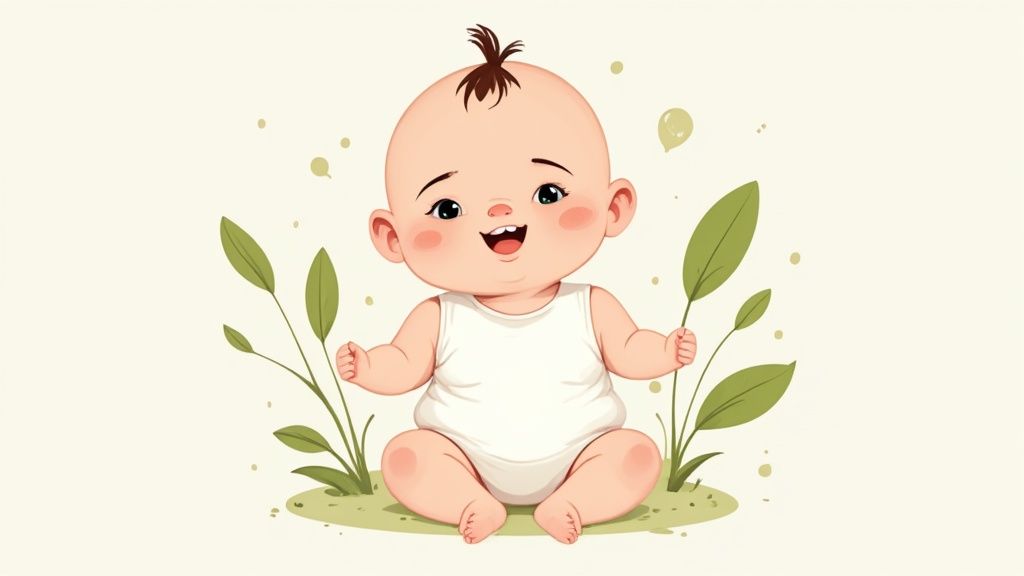
Choosing clothes for your little one goes way beyond picking out cute patterns. It's a decision that really affects their health and comfort every single day. That’s why so many parents are turning to organic baby clothes, and the reasons are pretty compelling.
Think about it like buying organic food. You pick the purest ingredients for what goes in their body, right? The same logic applies to what goes on their body. A baby’s skin is amazing, but it’s also incredibly delicate—it’s much thinner and more porous than our own. This means it absorbs things from its environment more easily.
Unfortunately, standard clothing can be loaded with stuff you don't want anywhere near your baby. We're talking pesticide residues from cotton farming, harsh chlorine bleaches, and dyes that contain heavy metals. When these chemicals hang around in the fabric, they can be absorbed by your baby’s skin and lead to irritation, rashes, or even eczema flare-ups.
The Gentle Barrier Your Baby Deserves
This is where organic clothes make all the difference. When you choose organic, you're getting fabrics that were grown and processed without that cocktail of chemicals. Organic cotton, for example, comes from fields that are free of synthetic pesticides and fertilizers. From the farm to the finished product, the whole process is designed to keep things pure.
So, what does that mean for your baby?
- Less Skin Irritation: Without all those chemical residues, organic fabrics are naturally hypoallergenic. They’re simply less likely to cause a reaction.
- Softer and More Comfortable: Organic fibers haven't been damaged by harsh treatments like bleaching, so they often feel much softer against the skin.
- Total Peace of Mind: There's a real comfort in knowing that your baby's onesies and PJs are free from anything harmful.
This can be a huge relief, especially for parents dealing with infant skin issues. If you're looking for more tips on this, our post on the best fabric for sensitive skin dives even deeper into how different materials can help.
At its heart, the idea behind organic clothing is simple: it creates a clean, safe, and gentle barrier between your baby and the world. It’s a simple way to cut down on their exposure to unnecessary chemicals when they're most vulnerable.
More Than Just Fabric
Ultimately, choosing organic is a simple act of care. It’s about making sure the first things that touch your baby’s skin are just as pure and gentle as your own hug. By understanding the "why," you can feel confident that you’re not just buying clothes—you’re investing in your baby’s well-being from day one.
Decoding the Labels: What GOTS Certification Guarantees
Walking down the baby aisle can feel like trying to learn a new language. You're bombarded with tags that say "natural," "eco-friendly," or "pure," but what do those words actually mean? Often, not much. They're marketing fluff without any real, enforceable standards behind them.
But amidst all that noise, one label cuts through the confusion: the Global Organic Textile Standard (GOTS). Don't think of it as just another sticker. Think of it as a rock-solid promise.
It’s your guarantee that from the moment a cotton seed is planted to the finished onesie in your hands, every single step has met the highest possible standards for safety, sustainability, and ethical production. It’s the one label that truly means you’re getting the best for your baby and the planet.
What a GOTS Tag Really Means
When you spot that GOTS logo, it means the product has passed a tough, top-to-bottom inspection. This isn't just about the final garment; it's about verifying the integrity of the entire journey, from the farm all the way to the factory floor.
So, what does this seal of approval actually lock in?
- Genuinely Organic Fibers: A garment has to be made with at least 95% certified organic fibers. This means no GMO seeds and absolutely no toxic pesticides or synthetic fertilizers were used to grow the crops.
- Clean and Safe Processing: All the dyes and chemicals used along the way must meet strict environmental and health safety rules. Nasty stuff like formaldehyde, heavy metals, and chlorine bleach are completely forbidden.
- Ethical and Fair Labor: GOTS also includes strict social criteria based on the key principles of the International Labour Organization (ILO). This ensures everyone involved—from the farmer to the seamstress—has safe working conditions and is paid a fair, living wage.
Simply put, GOTS sees the whole picture. It connects environmental health, your baby's safety, and social responsibility into one trustworthy standard.
GOTS vs. Other Labels
It’s easy to get lost in all the "green" claims out there. You might also see the OEKO-TEX label. While OEKO-TEX is a fantastic standard for textile safety—it tests the final product to make sure it’s free of a long list of harmful substances—it doesn't look at where the fibers came from or how they were grown. You can learn more by checking out our guide on what OEKO-TEX Standard 100 means.
GOTS is the only certification that covers the entire journey: organic farming, environmentally friendly processing, and socially responsible manufacturing. It’s the most complete and trustworthy indicator for finding the best organic baby clothes.
Parents are catching on, and the demand for this kind of transparency is growing fast. The organic baby clothing market was valued at about USD 2.02 billion in 2024 and is expected to jump to USD 3.39 billion by 2032. This surge is all about parents wanting clothes free from chemical residues that can irritate sensitive skin, which is exactly what GOTS-certified fabrics deliver.
This chart really puts the differences between conventional cotton and GOTS-certified organic cotton into perspective.
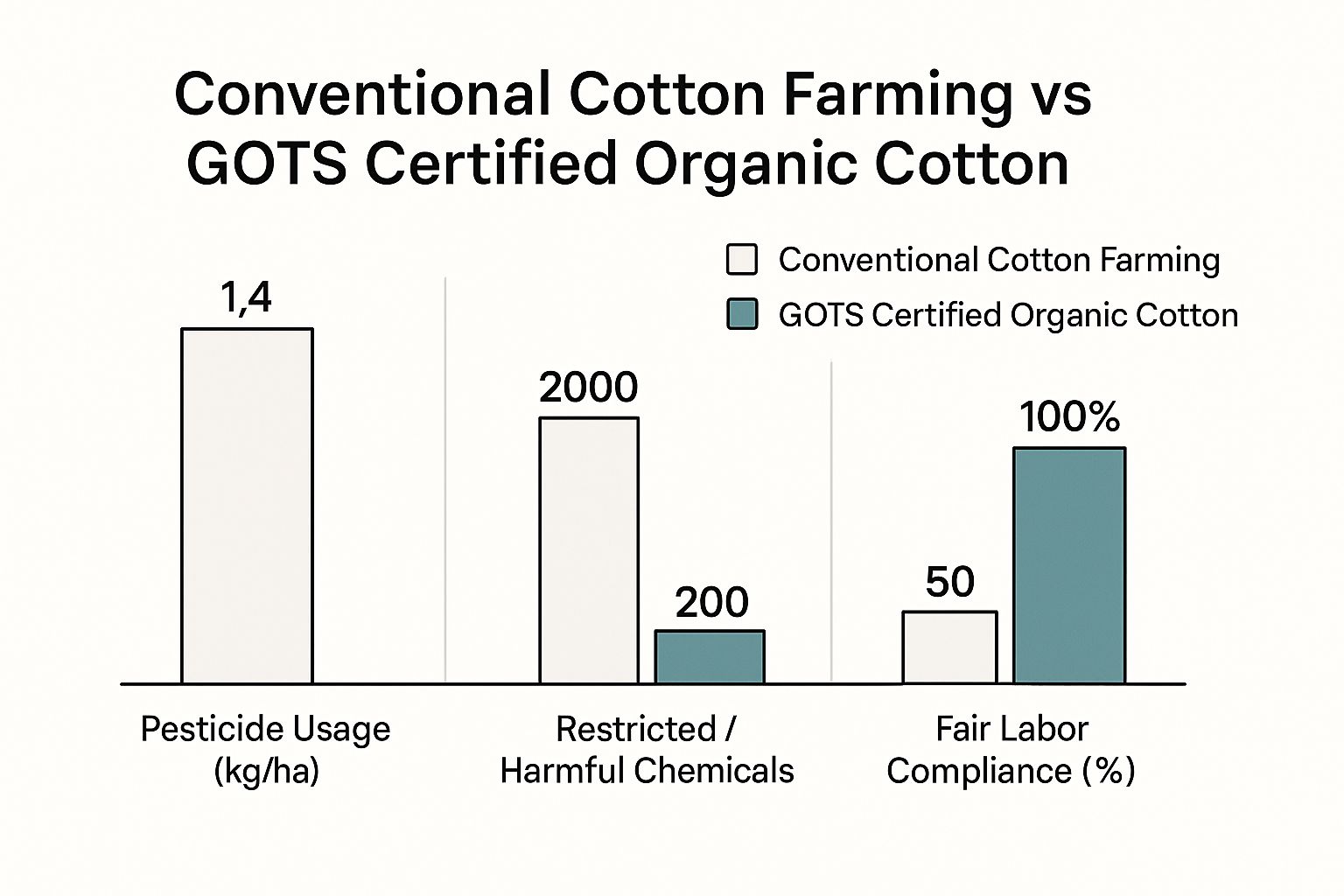
As you can see, the choice is clear. GOTS certification gets rid of toxic pesticides, dramatically cuts down on exposure to harmful chemicals, and makes sure people are treated fairly. When you choose GOTS, you’re not just buying a piece of clothing—you’re supporting a system that is fundamentally safer, kinder, and more ethical.
Choosing the Perfect Organic Fabric for Your Baby
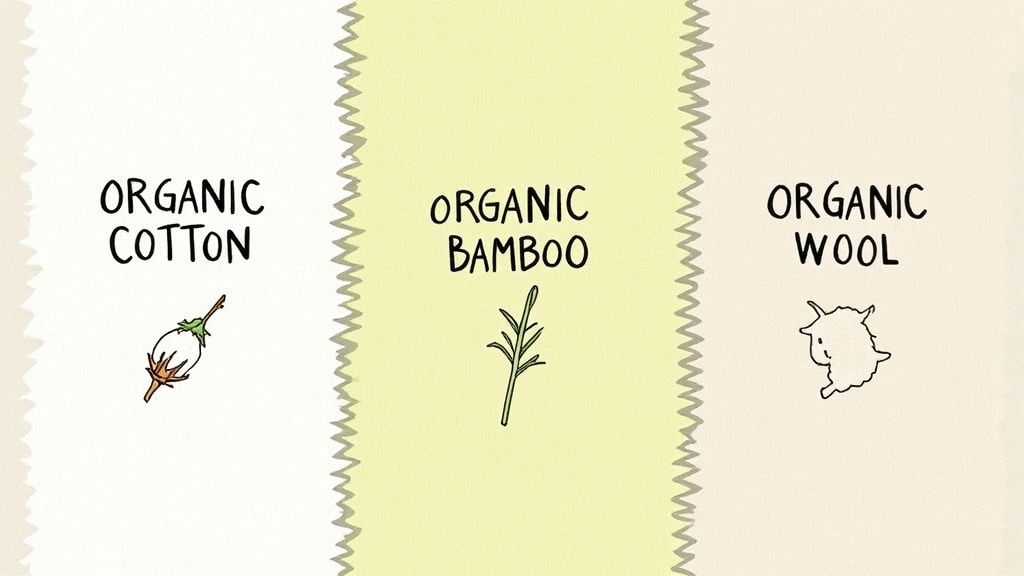
So, you’ve committed to organic. That’s awesome! The next thing you'll notice is that not all organic fabrics are the same—and that's a great thing. Each material has its own unique superpowers, making it perfect for different seasons, activities, and even skin types.
Think of it like stocking your kitchen pantry. You wouldn't just have one spice, right? Having the right fabric for the job makes dressing your baby so much easier. It's not just about what feels softest; it's about finding something breathable for a hot afternoon, something cozy for a chilly night, and something that won't irritate sensitive skin.
Let’s break down the most popular fabrics to help you find the best organic baby clothes for any situation.
Organic Cotton: The All-Around Champion
When you think of organic baby clothes, organic cotton is probably what comes to mind. It’s the undisputed star of the show, and for good reason! It’s durable, buttery-soft, and incredibly breathable, making it the perfect go-to for just about everything, from onesies to PJs.
Because it's grown without nasty pesticides and processed without harsh chemicals, organic cotton keeps its natural softness and strength. It’s like the difference between a farmers-market tomato and one from a giant supermarket—the natural version just feels and performs better. That purity makes it a fantastic choice for babies, as it’s much less likely to cause irritation or flare-ups.
Organic Bamboo: The Silky-Smooth Soother
If your little one has super sensitive or eczema-prone skin, organic bamboo might just be your new best friend. Bamboo-derived fabric is famous for its silky, almost cool-to-the-touch feel that glides over the skin instead of rubbing against it.
But the magic doesn't stop there. Bamboo is also a brilliant thermoregulator. What does that actually mean? Simply put, it helps keep your baby cool when it's warm and warm when it's cool. This amazing adaptability makes it perfect for sleepwear, helping your baby stay at a comfortable temperature all night long. It's also more absorbent than cotton and wicks moisture away from the skin, keeping them dry and happy.
The cotton vs. bamboo debate is a big one. If you're stuck between these two, you can dig deeper into this comparison of organic cotton vs. bamboo to figure out what’s right for your family.
Organic Wool: The Natural Insulator
Forget everything you think you know about itchy, scratchy sweaters. Modern organic merino wool is unbelievably fine, soft, and breathable—a world away from the wool of our childhoods. It’s a natural performance fiber that’s perfect for keeping your baby snug and warm without ever getting sweaty or overheated.
Organic wool is a true force of nature. It can absorb up to 30% of its own weight in moisture before it even feels damp. This is a game-changer for keeping your baby dry and comfy, especially overnight or on outdoor adventures.
Wool’s natural crimp creates tiny air pockets that trap body heat, providing incredible insulation. But at the same time, it’s remarkably breathable, letting any excess heat or moisture escape. This makes it the ideal material for base layers, sweaters, and sleep sacks when the temperature drops.
Making the Right Choice: A Simple Comparison
Feeling a bit overwhelmed with all the options? No worries. Sometimes seeing it all laid out makes the choice much clearer. This handy chart breaks down the basics to help you pick the perfect fabric for any situation.
Organic Baby Fabric Comparison Chart
| Fabric Type | Best For | Key Benefits | Care Instructions |
|---|---|---|---|
| Organic Cotton | Everyday wear, all seasons | Breathable, durable, soft, and hypoallergenic. A true workhorse. | Machine wash warm. Tumble dry low. |
| Organic Bamboo | Sensitive skin, sleepwear | Silky-smooth, thermoregulating, moisture-wicking, and gentle. | Wash cold on a gentle cycle. Line dry or tumble dry low. |
| Organic Wool | Cold weather, outdoor layers | Excellent insulation, breathable, moisture-absorbent, and odor-resistant. | Hand wash or machine wash on a wool cycle with wool-safe detergent. Lay flat to dry. |
Ultimately, the "best" organic fabric really depends on your baby's needs at that moment. You'll likely find that having a mix of all three in the closet is the real sweet spot—soft cotton for daily play, silky bamboo for a restful night's sleep, and cozy wool for those chilly winter outings. This way, you’re always prepared with the perfect blend of comfort, safety, and performance.
How Your Choice Helps Build a Healthier Planet
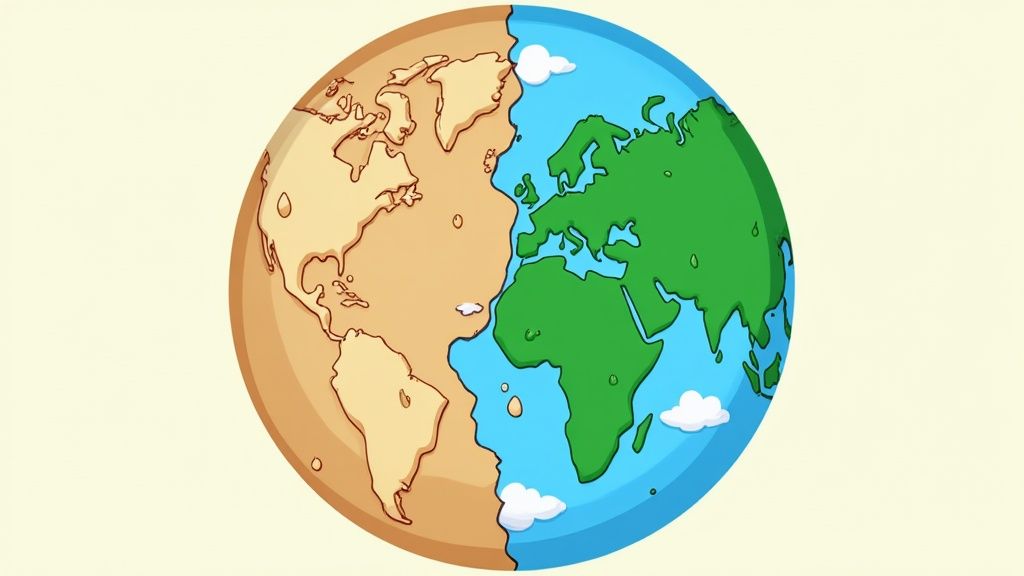
When you pick out that adorable organic onesie, you’re doing more than just protecting your baby’s sensitive skin. You're casting a small but mighty vote for the kind of world you want them to grow up in. That single choice sends a positive ripple out, starting right in the soil and touching farming communities across the globe.
To really get it, you have to look at the story behind the tag. Conventional cotton farming is a tough business, and it's incredibly tough on the environment. It often leans on a heavy-duty cocktail of synthetic pesticides and fertilizers just to get the job done.
But those chemicals don't just vanish. They seep into groundwater, run off into rivers, and throw delicate ecosystems out of whack. Over time, this whole process strips the soil of its nutrients, leaving it less fertile and in need of even more chemicals to produce a crop. It's a vicious cycle.
A Kinder Approach to Farming
Organic farming tells a completely different story. It’s all about working with nature, not trying to wrestle it into submission. Think of it more like tending a vibrant garden than running a sterile factory.
Organic farmers build rich, living soil using time-tested techniques like composting and crop rotation. By saying no to toxic pesticides, they create a safe haven for birds, bees, and other wildlife, which is a huge win for biodiversity. The result? Cleaner water, healthier land, and a much safer environment for the farmers and their families.
Choosing organic is really an investment in a system that nurtures the earth. It supports practices that leave the land better than it was found, ensuring a healthy planet for generations to come.
The Growing Movement of Conscious Consumers
This is exactly why so many parents are making the switch. The global market for organic baby clothes was valued at around USD 1.2 billion in 2023, but it’s expected to more than double to USD 2.8 billion by 2032. That's some serious growth, and it's all fueled by parents who want products that are safe for their kids and kind to the planet. You can read more about the trends shaping the organic baby clothing market if you're curious.
And this movement isn't just about the fabric. The best brands are looking at the whole picture—from eco-friendly packaging to more efficient production—to shrink their environmental footprint. When you buy organic, you're joining a massive, global community of people making thoughtful choices.
By choosing organic, you’re directly supporting a chain of positive impacts:
- Protecting Waterways: You're helping keep synthetic chemicals out of our rivers and oceans.
- Supporting Biodiversity: You're giving wildlife a healthier habitat where they can thrive.
- Improving Soil Health: You're backing farming methods that actually enrich the soil for the future.
- Ensuring Safer Conditions: You're protecting farmworkers from exposure to dangerous chemicals.
Every time you dress your baby in an organic sleeper or tee, you're a part of this beautiful story. It’s a simple, everyday act that helps build a cleaner, healthier world for the little adventurers we're all raising.
Keeping Your Organic Baby Clothes Soft and Strong
Let’s be honest, organic baby clothes are an investment. They’re an investment in your little one’s comfort and well-being, and just like any quality item—think of a favorite cozy sweater—they need a bit of TLC to stay at their best. With the right care, those buttery-soft onesies and sleep sacks will not only last through countless cuddles but can even become treasured hand-me-downs.
The good news? It's easier than you think. Forget harsh detergents and aggressive wash cycles. The secret to keeping organic fabrics looking and feeling new is to keep it simple and gentle. Since these clothes aren’t treated with the chemical softeners or synthetic finishes found on conventional garments, they really thrive with a more natural approach.
The Gentle Wash Cycle
The biggest difference you can make is in your washing machine. A few small tweaks to your routine can protect those delicate natural fibers for the long haul. Think of it less as a chore and more as a spa day for your baby's wardrobe.
Here’s a simple routine that works wonders:
- Go Cold: Always choose a cold wash on a gentle or delicate cycle. Hot water is the enemy of natural fibers—it can cause them to shrink and break down over time.
- Pick a Mild Detergent: Stick with a plant-based, fragrance-free detergent. The powerful surfactants and artificial scents in many mainstream detergents can irritate sensitive baby skin and are just too rough on soft organic cotton.
- Zip Up and Snap Shut: Before tossing everything in, take a second to close any zippers, snaps, or buttons. This one simple step prevents them from snagging and pulling on other clothes, which is a common cause of tiny holes and pilling.
- Sort Your Colors: It’s an old-school rule for a reason! Keeping whites, lights, and darks separate is the best way to prevent dye from bleeding and keep all those beautiful, earthy colors looking fresh.
This gentle method doesn't just protect the clothes; it's also kinder to the planet by using less energy. Win-win.
Tackling Stains the Natural Way
Babies are messy. It's just a fact of life. But stains don't have to spell the end for that adorable outfit. Instead of reaching for a chemical-heavy stain remover, you can handle most messes with things you likely already have on hand.
For everyday culprits like spit-up or pureed sweet potato, a simple paste of baking soda and water works miracles. A little dab of white vinegar can also do the trick. Just apply it to the spot, let it sit for a few minutes, and gently rub before washing. And don't underestimate the power of the sun! For stubborn stains on white or light-colored items, laying the damp garment in direct sunlight for a few hours is a fantastic natural bleach.
The real secret to stain removal? Speed. Get to that stain while it's fresh. It gives you a much better chance of lifting it completely without needing to use anything harsh.
Drying for Maximum Softness
How you dry your organic baby clothes is just as critical as how you wash them. High heat from a standard dryer is probably the number one cause of shrinkage and premature wear.
To keep everything in perfect shape, always tumble dry on the lowest heat setting. Or, even better, line-dry them outside whenever you can. It's the most gentle method by far, it saves a ton of energy, and leaves clothes with that amazing, fresh-air scent. If you find line-dried clothes feel a little crisp, just toss them in the dryer on a no-heat or air-fluff setting for five minutes with a few wool dryer balls. They'll soften right up.
Finding Affordable Organic Options Without Compromise
Let's be honest, the "organic" label can sometimes feel like it comes with a scary price tag. It’s easy to think that choosing the best organic baby clothes means blowing your budget, but that’s a myth I’m happy to bust. It’s not about spending more; it's about shopping smarter.
And you're not alone in wanting better for your baby. The entire baby apparel market hit about USD 227 billion in 2024, and a huge part of that growth is because more parents are actively looking for sustainable, non-toxic materials. It shows a real shift in priorities. You can dive deeper into the growing baby apparel market on imarcgroup.com to see the numbers for yourself.
But this trend doesn't mean you have to buy everything at boutique prices. It’s really about focusing on quality over quantity—and that’s where the savings begin.
Build a Smart Capsule Wardrobe
Instead of buying every cute outfit you see, try creating a capsule wardrobe for your little one. The whole idea is simple: you pick a small, carefully chosen set of high-quality basics in colors that all work together. This way, you can mix and match a few core pieces to create a surprising number of adorable outfits.
Think about it—a few versatile bodysuits, a couple of pairs of soft pants, one cozy cardigan, and a sleep sack or two can get you through almost anything. This minimalist mindset not only saves a ton of money but also cuts down on laundry and that "what should they wear today?" headache.
Shop with Savvy Timing
Patience is your best friend when it comes to saving money. If you time your shopping just right, you can snag some amazing deals on top-quality organic brands.
Here are a few tricks I’ve learned over the years:
- Watch for Seasonal Sales: Big sale events like Black Friday or end-of-season clearances are the perfect time to buy essentials for the next size up.
- Follow Your Favorite Brands: Get on those email lists and follow the brands you love on social media. That’s where they’ll drop exclusive discount codes and announce flash sales first.
- Explore Secondhand Platforms: Never underestimate the power of pre-loved clothes! Babies grow out of things so quickly that you can often find secondhand items that look brand new. Online marketplaces and local consignment shops are treasure troves for high-end organic brands at a fraction of the cost.
When you pair the capsule wardrobe idea with smart shopping habits, you can build a beautiful, high-quality organic collection for your baby. It’s proof that you don’t have to sacrifice your values or your baby’s comfort to stay on budget.
This approach lets you invest in pieces that are kind to your baby’s skin and the planet, all without stressing about your bank account. It’s truly the best of both worlds.
Your Top Questions About Organic Baby Clothes, Answered
Diving into the world of organic baby clothes brings up a lot of questions. That’s a good thing! It means you’re thinking carefully about what’s best for your little one. We get it, and we’ve heard them all.
Let's walk through some of the most common questions we hear from parents just like you, so you can feel totally at ease with your choices.
"Are Organic Clothes Actually Better for Sensitive Skin?"
Yes, and the difference is huge. Imagine conventional cotton as being treated with a whole cocktail of chemicals—pesticides in the field, harsh bleaches, and even formaldehyde in the finishing process. A baby's skin is so new and porous, it can easily react to these lingering residues.
Organic clothing, especially if it’s GOTS-certified, is a completely different story. It sidesteps all those harsh chemicals. The fibers are grown and processed cleanly, making them naturally hypoallergenic. This means a much lower risk of rashes, eczema flare-ups, or general irritation. It's the purest choice for the most delicate skin. If you're looking to create a gentler world for your baby, exploring other chemical-free baby products is a great next step.
It really boils down to this: organic fabric is pure fabric. When you take away the chemical irritants, what's left is a material that's just naturally kinder to your baby's skin.
"Why Are Organic Baby Clothes So Much More Expensive?"
That higher price tag isn't just for a fancy label—it reflects the real cost of creating something safely and ethically. When you buy organic, you're paying for a much cleaner, more responsible process from start to finish.
Here’s a quick breakdown of what’s behind the cost:
- Farming Done Right: Organic farming is hard work. It relies on things like crop rotation and manual weeding instead of just spraying chemical pesticides and herbicides.
- Paying for Trust: Getting a certification like GOTS isn't free. It involves rigorous inspections and fees to make sure every single step, from farm to factory, meets the highest standards.
- Supporting People: A core part of the GOTS standard is ensuring workers are paid fair wages and have safe conditions.
So, you're not just buying a sleeper. You’re truly investing in a healthier start for your baby, a cleaner planet, and a better life for the people who made the clothes.
"How Can I Be Sure Something is Truly Organic?"
This is such an important question. It's easy to get fooled by vague marketing terms like "natural" or "eco-friendly," which sound great but aren't regulated and don't mean much.
The best way to know for sure is to look for a third-party certification right on the tag. The Global Organic Textile Standard (GOTS) logo is your best friend here. It’s the top-tier certification because it doesn’t just look at the final piece of clothing. It vets the entire supply chain—from the seed planted in the ground to the final stitch—to ensure everything is organic, non-toxic, and made ethically. If you spot that GOTS logo, you can absolutely trust what you're buying.
At Little Venture Co., we believe in wrapping your little ones in the purest comfort. Our faith-inspired, Oeko-Tex® certified bamboo sleepwear is designed to be gentle on delicate skin while supporting a mission of care. Explore our collection of soft, safe, and meaningful apparel at https://littleventureco.com.
